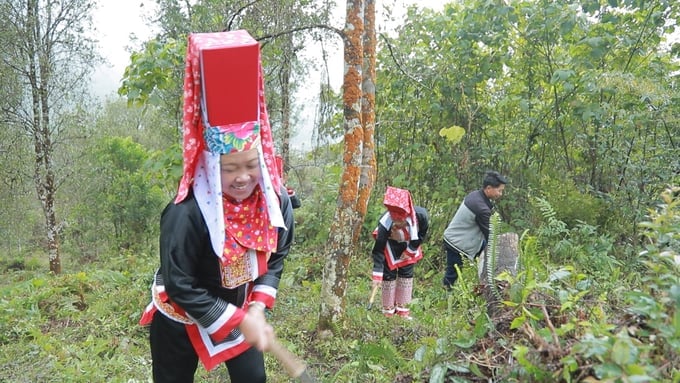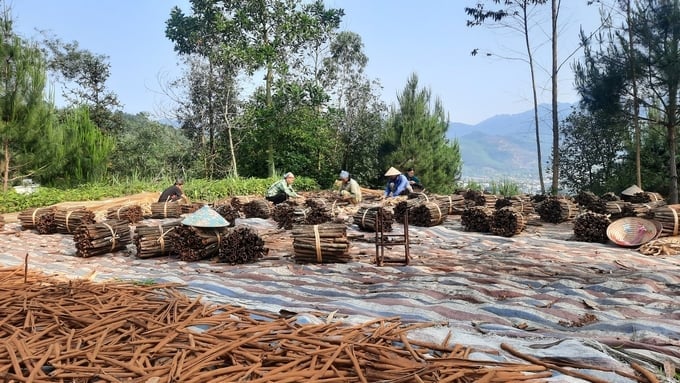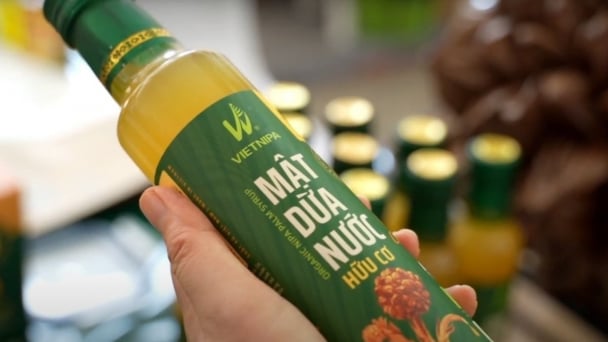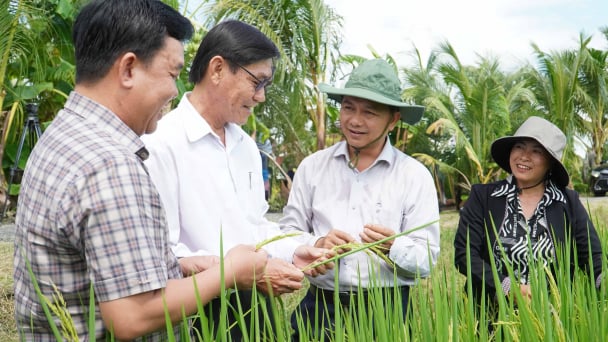June 27, 2025 | 15:40 GMT +7
June 27, 2025 | 15:40 GMT +7
Hotline: 0913.378.918
June 27, 2025 | 15:40 GMT +7
Hotline: 0913.378.918

The concentrated cinnamon planting area in Binh Lieu district is estimated at 680 hectares. Photo: Nguyen Thanh.
Binh Lieu is a mountainous district in the eastern part of Quang Ninh province, housing 18,000 hectares of protection forests and 22,000 hectares of production forests. With effective forest planning, protection and development, numerous households within the district have escaped poverty and profited from forest-based economies, particularly from cinnamon products.
Cinnamon is a perennial, woody tree capable of growing over 15 meters tall. Farmers in Binh Lieu district typically harvest cinnamon trees for their bark after approximately 10 years. Every part of the tree—trunk, branches, roots, and leaves—can be distilled into essential oils, used in medicine, or as a spice. Additionally, cinnamon trees are highly adaptable to Binh Lieu’s climate and soil, leading to their widespread production across the majority of the district’s communes.
Tang Dau Phong, a resident in Song Mooc village, Dong Van commune, Binh Lieu district, noted that cinnamon offers high economic value with multiple harvests and marketable components including bark, trunk, and leaves. Namely, a farmer can peel over 40 kilograms of cinnamon bark on a daily basis.
“My family has harvested and sold nearly 20 million VND worth of cinnamon since the beginning of the year. Last year, with fresh cinnamon bark priced at 20,000 VND per kilogram, our family earned over 80 million VND. The income from cinnamon helps us cover daily expenses and fund our children's education. This year, we are planting an additional 10,000 cinnamon trees to both reforest and increase our income,” Phong shared.
According to Binh Lieu district's Department of Agriculture and Rural Development, the estimated total economic value of one hectare of 15-year cinnamon tree is 580 million VND. Notably, primary revenue streams include pruning to collect branches, leaves, and bark; and final-year harvesting of branches, leaves, bark, timber, and other by-products such as seeds.
The average profit for cinnamon farmers is estimated at around 40 million VND per hectare per year, which is more than twice the profit from other timber trees. Depending on the quality, fresh cinnamon bark can be priced at 20,000 to 22,000 VND per kilogram, scrap bark at 15,000 to 16,000 VND per kilogram, and dried bark at 45,000 to 47,000 VND per kilogram.
Le Thi Thu Huong, head of Binh Lieu district's Office of Agriculture and Rural Development, reported that the district harvested 148 tons of dried cinnamon bark since the beginning of 2024, achieving 42% of the annual plan. The concentrated cinnamon production area is estimated at 680 hectares, with an additional 300 hectares of intercropped production area with star anise, pine, and others, accounting for nearly 5% of the district's total planted forest area. With an annual dried cinnamon bark yield of over 390 tons, Binh Lieu generates approximately 15 billion VND in revenue. Additionally, main cinnamon production regions include Huc Dong and Vo Ngai communes, and Binh Lieu town.

With an annual dried cinnamon bark yield of over 390 tons, Binh Lieu generates approximately 15 billion VND in revenue. Photo: Nguyen Thanh.
With the aim of enhancing the yield and quality of cinnamon, Binh Lieu district focused on promoting organic production and pest control practices. Moreover, the district organized training sessions on scientific and technical knowledge for intensive organic cinnamon cultivation, along with classes for key farmers to effectively implement the IPM program on cinnamon trees.
Accordingly, farmers can improve cinnamon yields and product quality by incorporating the sustainable cultivation and harvesting techniques covered in the training sessions into their own production processes.
On the other hand, the district is promoting collaboration between local businesses and farmers in developing organic cinnamon production areas that meet export market demands, with a focus on European, Indian, and Middle Eastern markets. The district is also encouraging investment in essential oil processing facilities to increase the value of cinnamon products.
The development of forest-based economies has markedly improved the lives of people in Binh Lieu district and other forested areas in Quang Ninh province. Binh Lieu district will continue allocating land and forest areas to local residents with the aim of maintaining responsible management over local forest area, thereby providing additional income sources and enhancing living standards.
According to the World Spice Association, Vietnam is a leading producer of valuable spice plants, with annual outputs among the highest globally for cinnamon and star anise. Notably, Vietnam ranks second in terms of star anise production and third in cinnamon production worldwide, with these spices remaining in high demand across numerous international markets, and generating significant revenue annually.
Translated by Nguyen Hai Long

(VAN) Nipa palm syrup is one of Ho Chi Minh City's typical agricultural products and has been certified as a 4-star OCOP item. The product is now ready to enter the global market.
/2025/06/17/3942-2-143243_548.jpg)
(VAN) Recently, in Sweden, the Secretary of the Binh Dinh Provincial Party Committee presented the Investment Registration Certificate for the 'Polyester Fabric Recycling Complex' project to SYRE Impact-AB Company.
/2025/06/12/3721-2-202745_83.jpg)
(VAN) TH made an impression at Seoul Food 2025 with its line of natural beverages, paving the way for Vietnamese food products to enter the South Korean market.

(VAN) Soc Trang's success in rice exports stems from a strategy of developing fragrant and specialty rice cultivation areas and standardizing production toward low-emission practices.
/2025/06/11/1311-5-120811_839.jpg)
(VAN) The pig farming industry is facing the challenge of comprehensive restructuring to meet requirements for quality, safety, traceability, and market expansion both domestically and for export.

(VAN) Vietnam considers participating in ALGROALBA in order to expand agricultural production, coordinate the assessment and effective exploitation potential land.
/2025/06/05/5314-1-184727_407.jpg)
(VAN) From seemingly worthless fish scales and skin, enzymes and lactic ferments can transform by-products into peptides, opening a sustainable, effective business direction and elevating Vietnamese seafood.